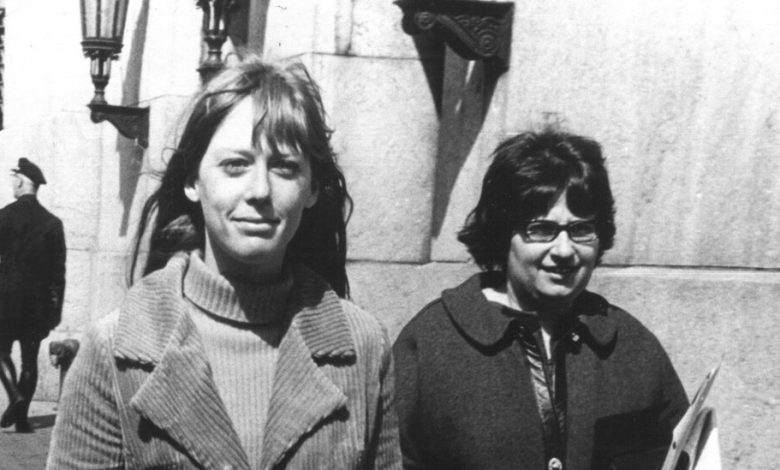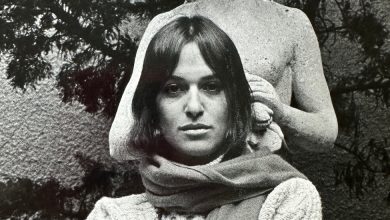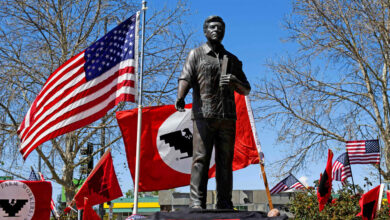Sally Kempton, Rising Star Journalist Turned Swami, Dies at 80

Sally Kempton, who was once was a rising star in the New York journalism world and a fierce exponent of radical feminism, but who later pivoted to a life of Eastern asceticism and spiritual practice, died on Monday at her home in Carmel, Calif. She was 80.
Her brother David Kempton said the cause was heart failure, adding that she had suffered from a chronic lung condition.
Ms. Kempton’s literary pedigree was impeccable. Her father was Murray Kempton, the erudite and acerbic newspaper columnist and a lion of New York journalism, the ranks of which she joined in the late 1960s as a staff writer for The Village Voice and a contributor to The New York Times. She was a sharp and talented reporter — although she sometimes felt she hadn’t properly earned her place as a journalist and owed it largely to her father’s reputation.
She wrote arch pieces about New Age fads like astrology: “One believes in marijuana and Bob Dylan,” she noted in The Times in 1969, and “astrology is part of an atmosphere which includes these things and others; it is one of the ways we speak to our friends.” She profiled rock stars like Frank Zappa and reviewed books for The Times.
She and a friend, the author Susan Brownmiller, joined a group called the New York Radical Feminists, and in the spring of 1970 they participated in a sit-in at the offices of Ladies’ Home Journal to protest its editorial content, which they said was demeaning to women. That same month, she and Ms. Brownmiller were invited on “The Dick Cavett Show” to represent what was then called the women’s liberation movement; the two had a set-to with Hugh Hefner, the publisher of Playboy magazine, who was also a guest, as was the rock singer Grace Slick (who did not seem totally on board with the feminist agenda).
But what made Ms. Kempton famous, for a New York minute, was a blistering essay in the July 1970 issue of Esquire magazine called “Cutting Loose,” in which she took aim at her father, her husband and her own complicity in the regressive gender roles of the era.
The basic point of the essay was that she had been groomed to be a certain kind of bright but compliant helpmeet, and she was spitting mad at herself for succeeding. Her father, she wrote, considered women to be incapable of serious thought and was skilled in the art of putting women down; their own relationship, she said, was like that of an 18th-century count and his precocious daughter, “in which she grows up to be the perfect feminine companion, parroting him with such subtlety that it is impossible to tell her thoughts and feelings, so coincident with his, are not original.”
She described her husband, the movie producer Harrison Starr, who was 13 years her senior, as “a male supremacist in the style of Norman Mailer” who infantilized her and provoked in her such frustration that she fantasized about bashing him in the head with a frying pan.
“It is hard to fight an enemy,” she concluded, “who has outposts in your head.”
The piece landed like a cluster bomb. Her marriage did not survive. Her relationship with her father suffered. Women devoured it, recognizing themselves in her furious prose. To a certain generation, it is still a touchstone of feminist exposition. Years later, Susan Cheever, writing in The Times, called it “a scream of marital rage.”
Four years after the Esquire piece was published, Ms. Kempton essentially vanished, to follow an Indian mystic named Swami Muktananda, otherwise known as Baba, a proponent of a spiritual practice known as Siddha Yoga. Baba was touring America in the 1970s and accruing devotees from the chattering classes by the hundreds and then the thousands — including, at one point, seemingly half of Hollywood.
By 1982, Ms. Kempton had taken a vow of chastity and poverty to live as a monk in Baba’s ashrams, first in India and then in a former borscht belt hotel in the Catskills. He gave her the name Swami Durgananda, and she donned the traditional orange robes of a Hindu monk.
After she was ordained, as she told the writer Sara Davidson, who profiled Ms. Kempton in 2001, she ran into a Sarah Lawrence classmate, who then wrote in the alumni newsletter, “Saw Sally Kempton, ’64, who is now married to an Indian man and is Mrs. Durgananda.”
As The Oakland Tribune reported in 1983, “The Sally Kempton who had written about sexual rage in Esquire no longer existed.”
Sally Kempton was born on Jan. 15, 1943, in Manhattan and grew up in Princeton, N.J., the eldest of five children. Her mother, Mina (Bluethenthal) Kempton, was a social worker; she and Mr. Kempton divorced when Sally was in college.
She attended Sarah Lawrence instead of Barnard, she wrote in her Esquire essay, because her boyfriend at the time thought it was a more “feminine” institution. There, she co-edited a magazine parody called The Establishment. She was hired by The Village Voice right after graduation and began writing pieces, as she put it, about “drugs and hippies” that she said were mostly made up because she had no idea what she was doing. (Her writing belied that assertion.)
She had her first ecstatic experience, she later recalled, in her apartment in the West Village, while taking psychedelics with a boyfriend and listening to the Grateful Dead song “Ripple.”
“All the complexities and the suffering and the pain and the mental stuff I was concerned with as a downtown New York journalist just dissolved, and all I could see was love,” she said in a video on her website. When she described her new insight to her boyfriend, she said, he responded by asking, “Haven’t you ever taken acid before?”
But Ms. Kempton had had a transformative experience, and she continued to have them as she began investigating spiritual practices like yoga and Tibetan Buddhism. She went to see Baba out of curiosity — everyone was doing it — and, as she wrote in 1976 in New York magazine, if you’re going to get yourself a guru, why not get a good one?
She was instantly pulled in, she wrote, charmed by his matter-of-fact persona as well as something more potent, if hard to define. Before long she had joined his entourage. It felt, she said, like running away with the circus.
Her friends were appalled. “But you were always so ambitious,” one said. “I’m still ambitious,” she said. “There’s just been a slight shift in direction.”
Ms. Kempton spent nearly 30 years with Baba’s organization, known as the SYDA Foundation, for two decades of which she was a swami. Baba died in 1982, following accusations that he had sexually abused young women in his ashrams; since his death, the foundation has been run by his successor, Gurumayi Chidvilasananda. In 1994, when Lis Harris, a writer for The New Yorker, investigated the foundation and wrote an article that noted the accusations against Baba and questions about his succession, she quoted Ms. Kempton as saying that the accusations were “ridiculous.” Ms. Kempton never spoke publicly about the issue.
In 2002, she put away her robes and left the ashram, moving to Carmel to teach meditation and spiritual philosophy. She was the author of a number of books on spiritual practices, including “Meditation for the Love of It: Enjoying Your Own Deepest Experience” (2011), which has an introduction by Elizabeth Gilbert of “Eat, Pray Love” fame.
In addition to her brother David, Ms. Kempton is survived by two other brothers, Arthur and Christopher. Another brother, James Murray Kempton Jr., known as Mike, was killed in a car crash with his wife, Jean Goldschmidt Kempton, a college friend of Sally’s, in 1971.
Ms. Kempton’s father, after his initial shock, was supportive of her new life. He was a spiritual man himself, a practicing Episcopalian, but humble about it. “I just go for the music,” he liked to tell people.
Murray Kempton, who died in 1997, visited the ashram and met with Baba a number of times, David Kempton said, and was respectful of the order’s ethos and history. He told The Oakland Tribune that if his daughter had wanted to be a druid he might have worried.
“I assume she knows something that I don’t know,” he said. “I respect her choice. In fact, I admire the choice Sally made. After all, she is a swami, isn’t she?”




